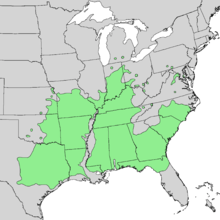Quercus shumardii
| Shumard oak | |
|---|---|
| | |
| Leaves of a Shumard oak in Austin, Texas | |
| Scientific classification | |
| Kingdom: | Plantae |
| (unranked): | Angiosperms |
| (unranked): | Eudicots |
| (unranked): | Rosids |
| Order: | Fagales |
| Family: | Fagaceae |
| Genus: | Quercus |
| Section: | Lobatae |
| Species: | Q. shumardii |
| Binomial name | |
| Quercus shumardii Buckland 1861 | |
 | |
| Synonyms[2] | |
|
Quercus schneckii Britton | |
Quercus shumardii, the Shumard oak, spotted oak, Schneck oak, Shumard red oak, or swamp red oak, is one of the largest of the oak species in the red oak group (Quercus section Lobatae). It is closely related to Texas red oak (Quercus buckleyi), Nuttall's oak (Quercus texana), and Chisos red oak (Quercus gravesii).
Distribution
Shumard oak is native to the Atlantic coastal plain primarily from North Carolina to northern Florida and west to central Texas; it is also found north in the Mississippi River Valley to central Oklahoma, eastern Kansas, Missouri, southern Illinois, Indiana, western and southern Ohio, Kentucky, and Tennessee. It is found locally north to southern Michigan, southern Pennsylvania, Maryland, western New York, and the extreme south of Ontario, Canada.[3][4]
Description
Mature Shumard oak typically reach heights of 25 to 35 meters (82 to 115 ft), trunk diameter is typically 60 to 100 centimeters (24 to 39 in), and crown width typically reaches 12 to 18 meters (39 to 59 ft) in width. Typical size varies according to region, with larger specimens occurring in the southern portions of its native range in the United States. Record Shumard oaks have been measured at up to 42 meters (138 ft) tall, with crowns up to 27.5 meters (90 ft) in width. Young specimens generally exhibit conic or ovate crowns, with the upper crown filling in as the tree reaches maturity. Trunks are relatively straight and vertical. Trunks may have deeply fluted buttresses near the ground. Shumard oak is typically found in lowland areas and is able to survive where the soils experience flooding for six weeks of the year.[5]
The young bark of the Shumard oak is light grey, very smooth, and very reflective. Shumard oak bark darkens and develops ridges and furrows as it ages. There are occasionally white splotches on the bark.[5]
Shumard oak twigs terminate in a cluster of buds. The buds are lighter in color than the olive-green twigs. The young twig is highly reflective.[5]

The leaves are arranged alternately and are broadly obovate with 5–9 lobes, each of which are terminated by bristle tipped teeth. The leaves mature to between 10 to 21 centimeters (4 to 8 in) in length. The surfaces are glabrous, except for the tufted vein axils. They are dark green on the top, while the bottom is a slightly lighter shade of green. The leaves turn brown to red in the fall, and sometime have hues of yellow mixed in. Fall colors are relatively late; specimens in central Texas may be at their most red in early December, while Florida specimens may not color substantially until February.[5]
Shumard oak bears relatively large acorns, which typically reach up to 3 centimeters (1 in) in diameter. Acorns take between 1.5 and 3 years to fully mature, and may go unnoticed during their early stages of development.[5]
The acorns of the Shumard oak provide food for various songbirds, game birds such as wild turkey and quail, waterfowl, white-tail deer, feral hogs, and various rodents such as squirrels. The leaves and twigs can also provide browse for white-tail deer.[5]
Diseases
Oak wilt can attack all red oaks, including the Shumard oak. Other diseases that attack Shumard oaks are various fungi that can grow on the leaves, powdery mildew, canker diseases, and shoestring root.[5]
Cultivation and uses
Shumard oak is valued for commercial use, as a shade tree, and as a food source for various birds and mammals. It is cultivated at least as far north as Ottawa, Ontario and as far south as Lake Worth, Florida. It is tolerant of wide ranges of pH levels in soil. It is drought-resistant, and prefers partial to full sunlight. Shumard oaks begin to bear seeds at a minimum of 25 years of age, and the optimum age for seed development is 50 years of age. Shumard oaks are known to have reached at least 480 years of age. The roots are intolerant to disturbance, so the tree should be planted in its permanent position at an early age.[5]
Shumard oak lumber is grouped with other red oak lumber for use in flooring, furniture, interior trim, decorative molding, paneling, and cabinetry. The lumber of Shumard oak is considered "mechanically superior" to that of other red oaks.[5]
References
- ↑ "Quercus shumardii", NatureServe Explorer, NatureServe, retrieved 2010-03-02
- ↑ The Plant List, Quercus shumardii Buckley
- ↑ "USDA PLANTS Database". http://plants.usda.gov. National Plant Data Team, Greensboro, NC 27401-4901 USA. Retrieved 5 March 2015. External link in
|website=(help) - ↑ Biota of North America Program 2014
- 1 2 3 4 5 6 7 8 9 Flora of North America: Quercus shumardii
- Edwards, M B (1990). "Quercus shumardii". In Burns, Russell M.; Honkala, Barbara H. Hardwoods. Silvics of North America. Washington, D.C.: United States Forest Service (USFS), United States Department of Agriculture (USDA). 2 – via Northeastern Area State and Private Forestry (www.na.fs.fed.us).
External links
- Ohio Trees
- Texas Native Trees
- Virginia Tech Dendrology
- Louisiana State University Agriculture Center
- United States Department of Agriculture plants profile
- Plants For A Future
- University of Florida
- Shumard oak at West Palm Beach, Florida
- Quercus shumardii images from Vanderbilt University
